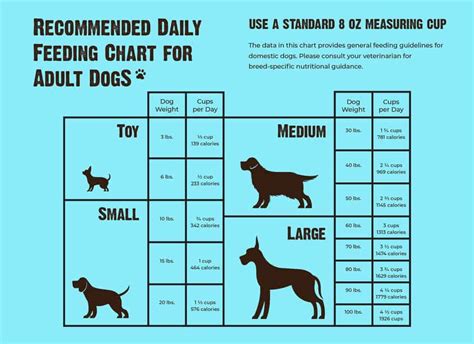Introduction
Every dog has unique nutritional needs tailored to its breed, size, and activity level. Providing the right nutrition is crucial for their health, happiness, and longevity. This in-depth guide explores the specific dietary requirements of various dog breeds, empowering pet owners to make informed choices that optimize their furry friend’s well-being.

Breed-Specific Nutritional Considerations
1. Small Breeds (e.g., Chihuahua, Toy Poodle, Yorkshire Terrier)
- Caloric Requirements: High due to their active metabolism
- Protein Needs: Moderate to high (25-30% of diet)
- Fat Content: Moderate (10-15% of diet)
- Fiber Content: Low (2-3% of diet)
- Key Nutrients: Omega-3 fatty acids, vitamin A, calcium
2. Medium Breeds (e.g., Beagle, Cocker Spaniel, English Bulldog)
- Caloric Requirements: Moderate to high
- Protein Needs: Moderate (18-25% of diet)
- Fat Content: Moderate (12-18% of diet)
- Fiber Content: Moderate (4-6% of diet)
- Key Nutrients: Antioxidants, vitamin E, glucosamine
3. Large Breeds (e.g., Golden Retriever, Labrador Retriever, German Shepherd)
- Caloric Requirements: High
- Protein Needs: High (20-27% of diet)
- Fat Content: High (15-20% of diet)
- Fiber Content: Low to moderate (2-4% of diet)
- Key Nutrients: Glucosamine, chondroitin, magnesium
4. Giant Breeds (e.g., Great Dane, Mastiff, Saint Bernard)
- Caloric Requirements: Very high
- Protein Needs: High (22-30% of diet)
- Fat Content: High (18-25% of diet)
- Fiber Content: Low (1-2% of diet)
- Key Nutrients: Calcium, phosphorus, joint supplements
Common Mistakes to Avoid
1. Overfeeding: Excess weight can lead to health issues like joint problems, diabetes, and heart disease.
2. Underfeeding: Malnutrition can result in stunted growth, weakness, and a weakened immune system.
3. Feeding Table Scraps: Human food can be unhealthy for dogs and cause digestive problems.
4. Ignoring Breed-Specific Needs: Not considering a breed’s unique requirements can lead to nutritional deficiencies or imbalances.
5. Switching Diets Too Often: Abrupt diet changes can cause digestive upset and other health issues.
FAQs
1. What is the best way to determine my dog’s nutritional needs?
Consult with a veterinarian or a qualified pet nutritionist.
2. How often should I feed my dog?
Small breeds may need to eat three to four times a day, while larger breeds can eat twice a day or less.
3. Should I give my dog supplements?
Some supplements may be beneficial, but always consult with a veterinarian before giving them to your dog.
4. What if my dog has food allergies?
Identify the allergen and eliminate it from their diet. Consider a hypoallergenic diet prescribed by a veterinarian.
5. How can I prevent my dog from gaining weight?
Control portion sizes, increase exercise, and avoid unhealthy treats.
6. What are the signs of malnutrition in dogs?
Common symptoms include poor coat health, weight loss, lethargy, and digestive problems.
Market Insights
1. Growing Awareness of Breed-Specific Nutrition
Pet owners are becoming increasingly aware of the importance of breed-specific diets. This trend is expected to continue, driving demand for specialized dog food products.
2. Rise of Personalized Pet Food
Customizable pet food services are gaining popularity, offering personalized diets tailored to a dog’s individual needs.
3. Demand for Premium Dog Food
Consumers are willing to pay a premium for high-quality dog food that meets their breed’s specific requirements.
Highlights of Dog Nutrition in 2025
1. Precision Nutrition: Advanced technologies will enable the development of diets tailored to a dog’s genetic profile.
2. Sustainable Diets: Pet food companies are embracing environmentally friendly practices, reducing waste and promoting sustainability.
3. Telemedicine Integration: Veterinarians will provide remote consultations on dog nutrition, making it convenient for pet owners.
Standing Out in the Dog Nutrition Market
1. Innovate: Introduce novel products and services that meet evolving dog nutrition needs.
2. Personalize: Offer customized diets and tailored recommendations based on breed and individual requirements.
3. Empower: Educate pet owners on the importance of breed-specific nutrition and provide them with the tools to make informed choices.
Conclusion
Understanding the unique nutritional requirements of different dog breeds is essential for optimizing their health and well-being. By providing tailored diets, avoiding common mistakes, and staying informed about market trends, pet owners can ensure that their furry companions thrive for years to come. As the dog nutrition landscape continues to evolve, innovation, personalization, and empowerment will be key to standing out in this competitive market.





















